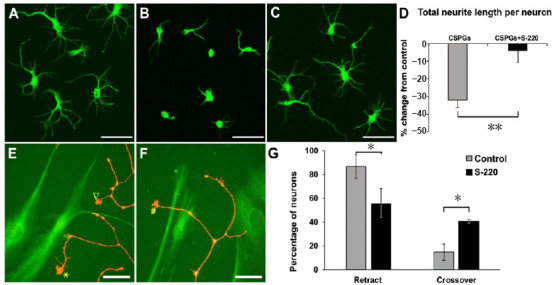Figure 4.

The Epac2 agonist overcomes inhibitory environments for cortical and DRG neuron growth.
(A) β-Tubulin-III positive cortical neurons grew neurites on PDL coated coverslips; (B) cortical neurons treated with CSPGs showed significantly shorter neurite lengths compared to control. (C) Epac2 agonist S-220 attenuated the inhibitory effect of CSPGs on cortical neurite outgrowth. (D) Quantification represents the percentage of change from control and shows a significant reduction in inhibition by CSPGs when S-220 was simultaneously applied. Cultures were grown for 48 hours. (E–G) S-220 also showed the effect in overcoming the astrocyte inhibition. Three neurite growth cone behaviours of DRG neurons co-cultured with mature astrocytes were observed: retract (▽ in E), reflect (* in E) and crossover (# in F) using time-lapse live cell microscopy. G, the quantification showed a significant reduction in the retract/reflect behaviors of neurites and a significant increase in the crossover behavior of neurites in cells treated with the Epac2 agonist when compared to control. (D, G) Mann-Whitney Rank Sum test, *P < 0.05, **P < 0.01, n = 3/group. Scale bars: A–C, 50 µm; E and F, 25 µm. Adapted from Guijarro-Belmar et al. (2019). CSPGs: Chondroitin sulphate proteoglycans; DRG: dorsal root ganglion; PDL: poly(D,L-lactide).
